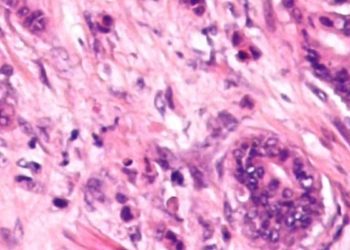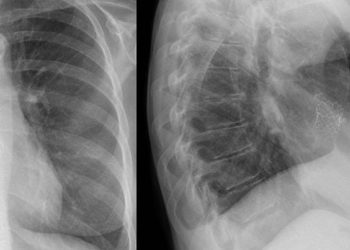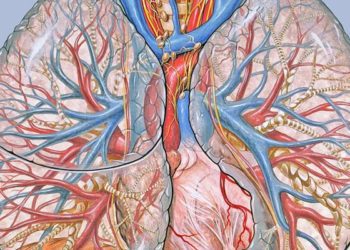Dual-function nanoparticles deliver anti-tumor compounds and track treatment efficacy [PreClinical]
1. The authors designed reporter nanoparticles (RNPs) that 1) delivered a chemotherapeutic or immunotherapeutic agent and 2) emitted fluorescence when activated by the apoptosis enzyme caspase-3.
2. In several murine models of cancer, RNPs slowed tumor growth, differentiated between chemosensitive and chemoresistant tumors, and improved detection of early treatment response over traditional imaging methods.
Evidence Rating Level: 2 (Good)
Study Rundown: Traditional imaging modalities such as computer tomography (CT) and positron emission tomography (PET) are used to measure responses to anti-tumor therapy. However, these approaches lack the sensitivity needed to detect early responses to treatment. Further, in the case of immunotherapy, they cannot distinguish between malignant tumor growth and growth associated with productive immune cell infiltration.
To address these limitations, the authors developed nanoparticles that can deliver a chemotherapeutic (paclitaxel) or immunotherapeutic (anti-PD-L1) agent and also generate a fluorescent signal in response to treatment-associated activation of the apoptosis pathway. In a mouse model of breast cancer, paclitaxel-containing RNPs reduced tumor growth rate and generated detectable fluorescence signals as early as 8 hours after therapy initiation. The RNPs were then tested in a second model, in which paclitaxel-sensitive and -resistant prostate cancer cell lines were implanted into mice. Paclitaxel-sensitive tumors displayed fluorescence activation within 12 hours after the first of two doses of RNPs. Immunohistochemistry analysis of the tumors confirmed an increase in caspase-3 within the chemosensitive tumors. Finally, using a mouse model of melanoma, the authors demonstrated that RNPs carrying anti-PD-L1 antibody successfully induced apoptosis, generated fluorescent signals, and initiated T cell infiltration into tumors. In contrast, CT and PET imaging of these RNP-treated mice did not detect any changes between the control and RNP-treated groups even one week after treatment.
This work demonstrated the capability for nanoparticles to be used as indicators of early therapeutic efficacy in addition to drug delivery vehicles. However, for this technology to be translated to the clinic, further studies demonstrating treatment efficacy and safety are necessary. More importantly, the RNPs must also be adapted for non-invasive imaging through deep tissues by using radiocontrast dyes in place of the fluorescent indicators.
Click to read the study in PNAS
Relevant Reading: Non-invasive detection of apoptosis using magnetic resonance imaging and a targeted contrast agent
In-Depth [animal study]: In the first in vivo experiment, 4T1 breast cancer cells were implanted into BALB/c mice 10 days before the initiation of RNP treatment. Compared to control nanoparticles with no paclitaxel, RNPs slowed the increase in relative tumor volume by ~50% after 11 days since the start of treatment. In mice treated with RNPs, tumors also generated significantly greater fluorescence signals relative to normal tissue over 8 days (p<0.05).
In the second mouse model, paclitaxel-sensitive (DU145) and -resistant (DU145TR) prostate cancer cell lines were injected into the right and left flanks, respectively, of BALB/c athymic mice. When evaluated 2 days after the second/final RNP dose was administered, DU145 tumors generated a ~400% increase in fluorescence whereas DU145TR tumors exhibited little to no change in fluorescence as compared to normal tissue. As expected, staining of the drug-sensitive and -resistant tumors after treatment revealed a qualitative increase in caspase-3 levels in DU145 tumors.
In the final in vivo model, B16/F10 melanoma cells were implanted into C57BL/6 mice 10 days before RNP treatment. When compared to control RNPs, anti-PD-L1 RNPs significantly increased fluorescence from tumors (p<0.05) and induced greater activation of caspase-3 as measured by Western blot of tumor tissue samples. Flow cytometry of isolated tumor cells illustrated a ~200% increase in the number of CD8+ T cells from tumors in RNP-treated animals relative to the control group (p<0.05). Imaging of these animals with PET with 2-[fluorine-18]fluoro-2-deoxy-d-glucose (FDG-PET) and CT indicated no significant decreases in the uptake of [18F]FDG with RNP treatment, suggesting that traditional imaging modes for monitoring treatment efficacy were insensitive to the small changes in early response detected by RNPs.
Image: PD
©2016 2 Minute Medicine, Inc. All rights reserved. No works may be reproduced without expressed written consent from 2 Minute Medicine, Inc. Inquire about licensing here. No article should be construed as medical advice and is not intended as such by the authors or by 2 Minute Medicine, Inc.







